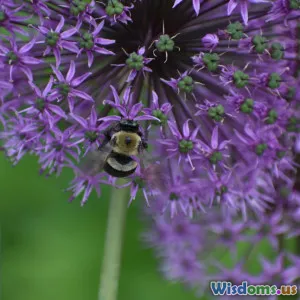
Five Surprising Impacts Lightning Has on Local Ecosystems
9 min read Explore five unexpected ways lightning shapes local ecosystems, from nutrient cycling to biodiversity impacts. (0 Reviews)
Five Surprising Impacts Lightning Has on Local Ecosystems
Lightning is a phenomenon that has captivated humanity for millennia—massive bolts of electricity igniting the sky with a brilliant flash, followed by thunderous roars. While many appreciate lightning for its sheer power and danger, its ecological significance is often underappreciated. Beyond the spectacle and the hazards, lightning quietly influences the functioning of many terrestrial ecosystems in profound, often surprising ways.
In this article, we explore five little-known yet fascinating impacts lightning has on local ecosystems. From boosting soil fertility to altering wildlife behavior, lightning’s imprint on nature is far more complex and meaningful than one might expect.
1. Lightning Bolts Spark Nitrogen Fixation, Enriching Soils
Nitrogen is a critical nutrient for plant growth, but although the atmosphere consists of about 78% nitrogen gas (N₂), most plants cannot use it in that form. It must first be “fixed” — converted into reactive forms like nitrates or ammonium.
One natural nitrogen fixation mechanism involves lightning. The intense energy in lightning bolts causes nitrogen (N₂) and oxygen (O₂) molecules in the atmosphere to combine and form nitrogen oxides (NO_x). These compounds dissolve in rainwater and shower down onto the soil, enriching it with bioavailable nitrogen essential for plant and microbial life.
Scientific Evidence
- According to studies published by the National Atmospheric Research Laboratory India, a single lightning storm can fix up to 5-10 million tons of atmospheric nitrogen globally each year.
- Research in the Amazon rainforest has shown that lightning contributes significantly to soil nutrient cycles, supplementing nitrogen beyond biological fixation by bacteria.
Why This Matters
In nutrient-poor ecosystems such as certain forests and grasslands, this lightning-driven nitrogen input can influence plant productivity and overall ecosystem health. It's nature’s way of fertilizing the land without human intervention.
2. Lightning Acts as a Natural Wildfire Trigger, Shaping Biodiversity
While much attention focuses on human-caused wildfires, lightning remains one of the primary natural ignition sources worldwide. Lightning strikes can ignite dry vegetation, leading to wildfires that dramatically reshape landscapes.
The Dual Role of Wildfires
- Destructive Yet Regenerative: Wildfires can destroy habitats temporarily but also play a crucial ecological role. Many ecosystems, such as savannas, pine forests, and chaparral, depend on periodic fires to maintain species diversity.
- Species Adaptations: Plants like the Lodgepole pine in North America rely on fire to open their cones and release seeds, enabling regeneration.
Case Study: Yellowstone and Lightning
Lightning-caused fires were central to the 1988 Yellowstone fires, one of the largest wildfire events in U.S. history. Post-fire studies revealed:
- Increased biodiversity due to a mosaic of burned and unburned habitats.
- A surge in fire-adapted species like aspens and fireweed.
- Improvement in water quality and nutrient cycling.
These insights underscore how lightning’s role in natural disturbance regimes maintains ecological balance over time.
3. Lightning Influences Wildlife Behavior and Ecology
Lightning and the thunderstorms they accompany impact animal behavior in surprising ways:
- Migration and Movement: Birds and other wildlife often alter flight paths during thunderstorms to avoid lightning risks. Some species defer migration during electrified weather.
- Communication: Frogs and insects sometimes take advantage of post-storm conditions to increase mating calls, possibly due to higher humidity and calmer air.
- Predator-Prey Dynamics: Flashes of lightning can momentarily illuminate nocturnal environments, affecting hunting strategies of predators like owls and bats.
Example: Elephants and Lighting
A study conducted in African savannas found elephants often avoid areas with high lightning occurrence during thunderstorms, possibly as an evolved behavior to reduce injury risk.
4. Lightning Induces Atmospheric Chemistry Changes Affecting Ecosystem Processes
Lightning produces not only nitrogen oxides but also influences atmospheric chemistry in ways that indirectly affect ecosystems.
- Ozone Formation: Lightning-generated nitrogen oxides contribute to tropospheric ozone creation. While ozone high in the atmosphere protects life from ultraviolet light, near the surface it can affect plant physiology negatively or sometimes regulate disease.
- Aerosol Particle Formation: Electrical charges from lightning can facilitate the formation of aerosols, which influence cloud formation and precipitation patterns, effectively shaping local climate and ecosystem water availability.
Scientific Insight
Research published in the Journal of Geophysical Research links lightning activity with variations in local rainfall. This connection means ecosystems influenced by lightning can experience changes in water input, affecting plant growth cycles and habitat suitability.
5. Lightning Creates Microhabitats That Foster Unique Biodiversity
Some ecologists have found that the legacy of lightning strikes includes the creation of specialized microhabitats:
- Charred Tree Hollows: Lightening strikes can hollow out tree trunks, producing cavities that become critical nesting or shelter sites for species like owls, woodpeckers, and bats.
- Soil Disturbances: The intense heat of lightning can volatilize organic matter, alter soil pH locally, and create nutrient-rich patches promoting certain plants and microorganisms.
- Ephemeral Ponds: Liquid water generated by melted ice or subsequent storms following lightning can create temporary wet areas used by amphibians and insects for breeding.
Example
In Australian eucalyptus forests, charred pillars left by lightning have been documented hosting rare insects and moss species uniquely adapted to these post-strike microhabitats.
Conclusion
Lightning’s role in local ecosystems is multifaceted and often counterintuitive. Beyond the awe-inspiring bolt of electricity, lightning acts as a natural fertilizer, a catalyst for wildfire-driven biodiversity, a modulator of animal behavior, a driver of atmospheric chemical processes, and a creator of unique habitats.
Understanding these surprising impacts enriches our appreciation of natural systems' intricacy and interconnectedness. It also highlights the importance of preserving the natural wildfire regimes and atmospheric dynamics that help maintain robust and resilient ecosystems.
As climate change alters lightning frequency and intensity in many parts of the world, recognizing how these changes might ripple through ecosystems becomes vital for conservation and environmental management strategies. Lightning, in all its fiery drama, truly belongs to nature’s stewardship toolkit—shaping the world far beyond the skies it illuminates.
References:
- National Atmospheric Research Laboratory, India, Nitrogen Fixation by Lightning
- Keeley, J.E. Fire as an ecological factor, 2009
- Yellowstone National Park wildfire reports, 1988
- African Savanna wildlife behavioral studies, 2017
- Journal of Geophysical Research, 2020, Lightning and atmospheric chemistry
- Ecological Monographs, Lightning-created microhabitats in Australia, 2015
Author Note: This article integrates scientific research with real-world examples to offer a comprehensive view of how lightning interacts with ecosystems globally.
Rate the Post
User Reviews
Popular Posts















